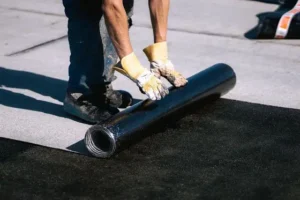Root-proof waterproofing membrane is the basis and guarantee of waterproofing project quality. Waterproofing membrane is a kind of waterproofing membrane used in waterproofing project construction. In order to achieve better drainage effect, the products of Huafeng Building Waterproofing Engineering Co., Ltd. must meet the design requirements. Let’s introduce the common characteristics of building waterproofing materials in detail.
1. It has good weather resistance and must have a certain tolerance to photosensitivity, heat and ozone.
2. The modified root-proof membrane has water permeability, acid and alkali resistance.
3. It must have a certain adaptability to external temperature and external force, that is, the material must have high tensile strength, large elongation at break, and can withstand temperature changes, deformation caused by various external forces, and expansion and cracking of the base layer.
4. Good integrity, can maintain its own adhesion, and can be firmly bonded to the base layer. At the same time, it has a high peeling strength under the action of external force to form a stable watertight whole.
Waterproofing projects have different construction methods under different circumstances, and the performance requirements for waterproof materials must also have different focuses. For example, when using anti-root membranes in underground waterproofing projects, they must have high-quality impermeability, elongation and good overall resistance to permeability. Of course, these requirements are due to the continuous erosion of groundwater, high water pressure and possible deformation of underground structures.
The construction steps of anti-root membranes are as follows:.
1.After cleaning the base, first reinforce and treat key parts such as corners, expansion joints, and construction joints. Pay special attention to hard-to-reach areas like drainage holes—apply waterproof primer 2-3 times for reinforcement.
2. Ready-made anti-root membranes should be divided into waterproof coatings, base coatings and adhesive membrane coatings. The primer is used to improve the adhesion between the waterproof membrane and the base. The primer can be repeatedly and evenly applied to cover and penetrate into the concrete base, thereby improving the bonding strength and shear strength.
3. The waterproof coating should be prepared according to the product instructions, A: B = 2:1. The amount of each mixing should be consistent with the actual mixing amount on site.
4. Stir the waterproof coating evenly for about 3-5 minutes until component A and component B are evenly mixed.
5. Stir the waterproof coating evenly according to the area of the site. The base coating area should be larger than the bonding membrane area. The waterproof coating should not exceed 30 minutes from the end of stirring to the end of painting.
6. After the initial pouring of about 4 minutes to 8 hours, you can apply the primer twice, and then three times. The thickness of one brush is about 0.5mm, the thickness of the second brush is about 0.5mm, and the thickness of the three brushes is about 0.5mm. You must wait until the first layer is completely cured before applying the second layer.
7. When applying the roll material, you can allow the second layer of paint to cure completely before construction. (Depending on the actual conditions and thickness requirements of the project site, you may brush or spray the waterproof coating multiple times, but remember to complete each application in one go.) Workers typically use this method for constructing root-resistant membrane structures. The required tools include blowers, dust collectors, various roller brushes, mixing barrels, paint mixers, and motor vehicles.
Contact Us
For more information or to inquire about our waterproof floor paint solutions, feel free to get in touch with us. We’re here to help!
- Phone: +86 138 6365 6701
- Email: Huafengwaterproof@gmail.com
- WhatsApp: +86 138 6365 6701
We look forward to assisting you with all your waterproofing needs!






